University Healthcare Quality Report: Analysis and Recommendations
VerifiedAdded on 2023/06/07
|11
|3386
|421
Report
AI Summary
This report delves into the critical aspects of managing quality in healthcare, emphasizing the importance of providing effective and safe medical services to improve patient outcomes. It explores various facets of healthcare quality, including the impact of poor quality of care on patients, the barriers hindering access to healthcare, and the significance of quality management. The report outlines methods to assess health outcomes and enhance quality, such as implementing quality management systems, prioritizing resources, managing risks, and providing regular training for employees. Furthermore, it discusses the importance of patient participation, systematic policy implementation, and the use of quality indicators to improve healthcare services for all individuals. The report concludes by highlighting the need for patient-centered care and methods to safeguard vulnerable populations, offering a comprehensive overview of strategies to enhance healthcare quality and ensure better patient experiences.
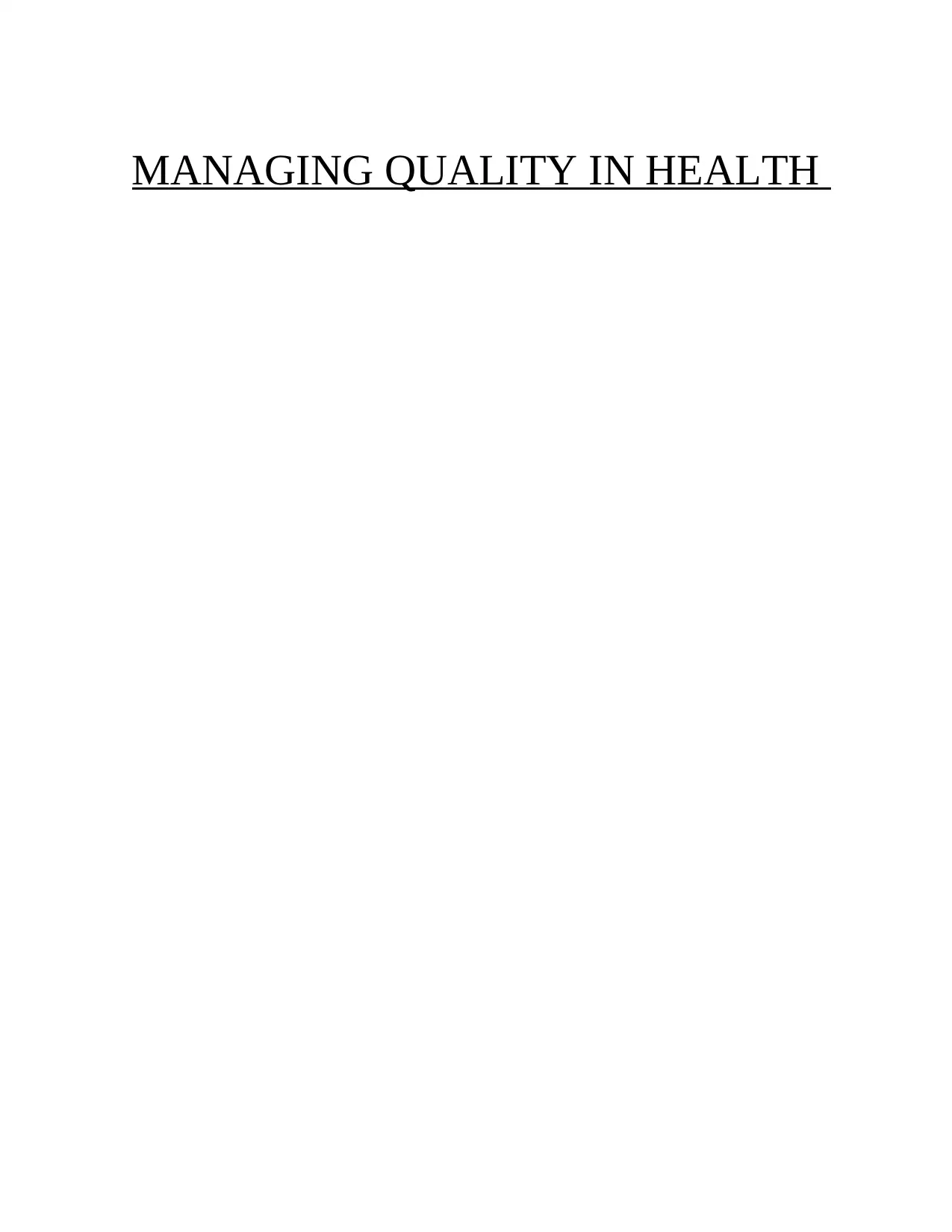
MANAGING QUALITY IN HEALTH
Paraphrase This Document
Need a fresh take? Get an instant paraphrase of this document with our AI Paraphraser
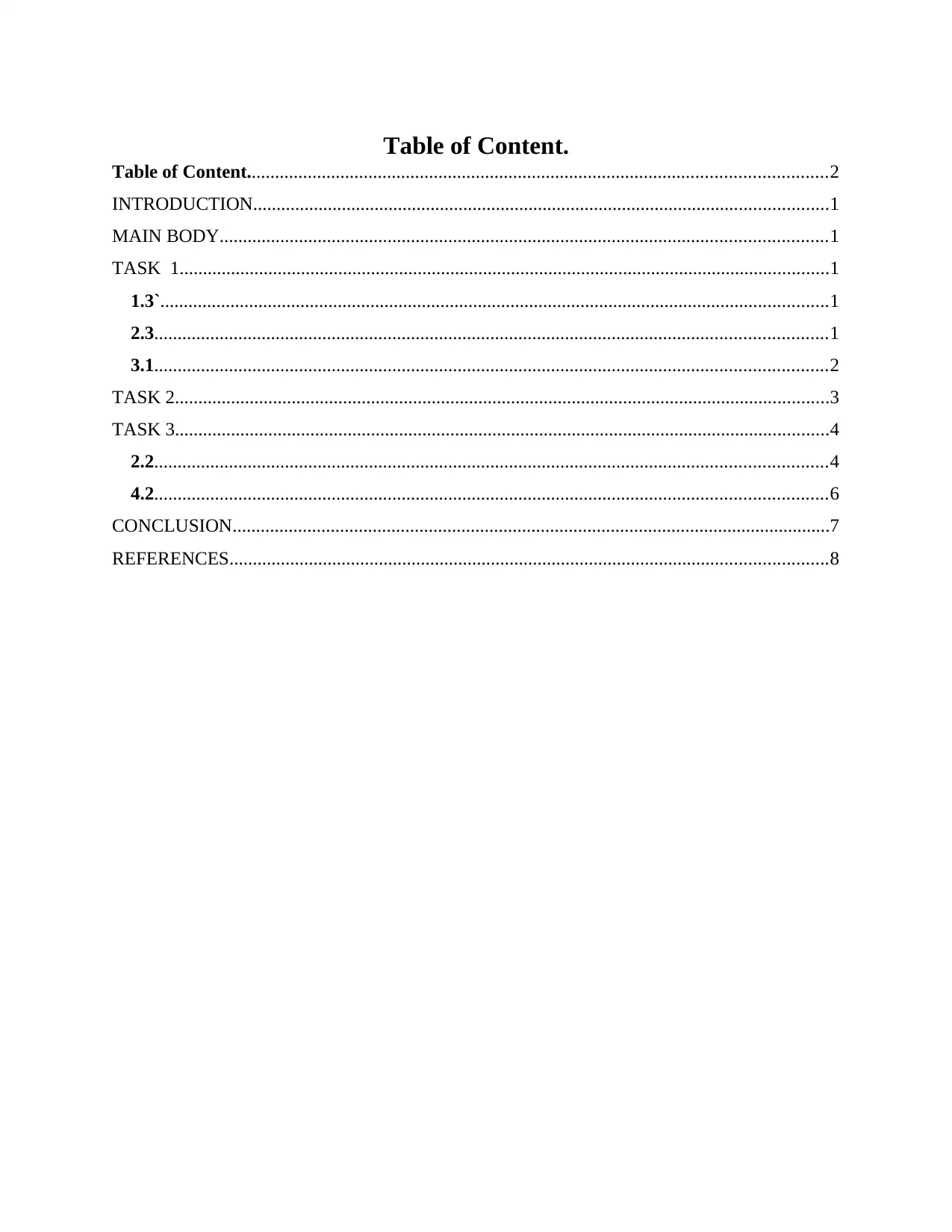
Table of Content.
Table of Content............................................................................................................................2
INTRODUCTION...........................................................................................................................1
MAIN BODY..................................................................................................................................1
TASK 1...........................................................................................................................................1
1.3`...............................................................................................................................................1
2.3................................................................................................................................................1
3.1................................................................................................................................................2
TASK 2............................................................................................................................................3
TASK 3............................................................................................................................................4
2.2................................................................................................................................................4
4.2................................................................................................................................................6
CONCLUSION................................................................................................................................7
REFERENCES................................................................................................................................8
Table of Content............................................................................................................................2
INTRODUCTION...........................................................................................................................1
MAIN BODY..................................................................................................................................1
TASK 1...........................................................................................................................................1
1.3`...............................................................................................................................................1
2.3................................................................................................................................................1
3.1................................................................................................................................................2
TASK 2............................................................................................................................................3
TASK 3............................................................................................................................................4
2.2................................................................................................................................................4
4.2................................................................................................................................................6
CONCLUSION................................................................................................................................7
REFERENCES................................................................................................................................8
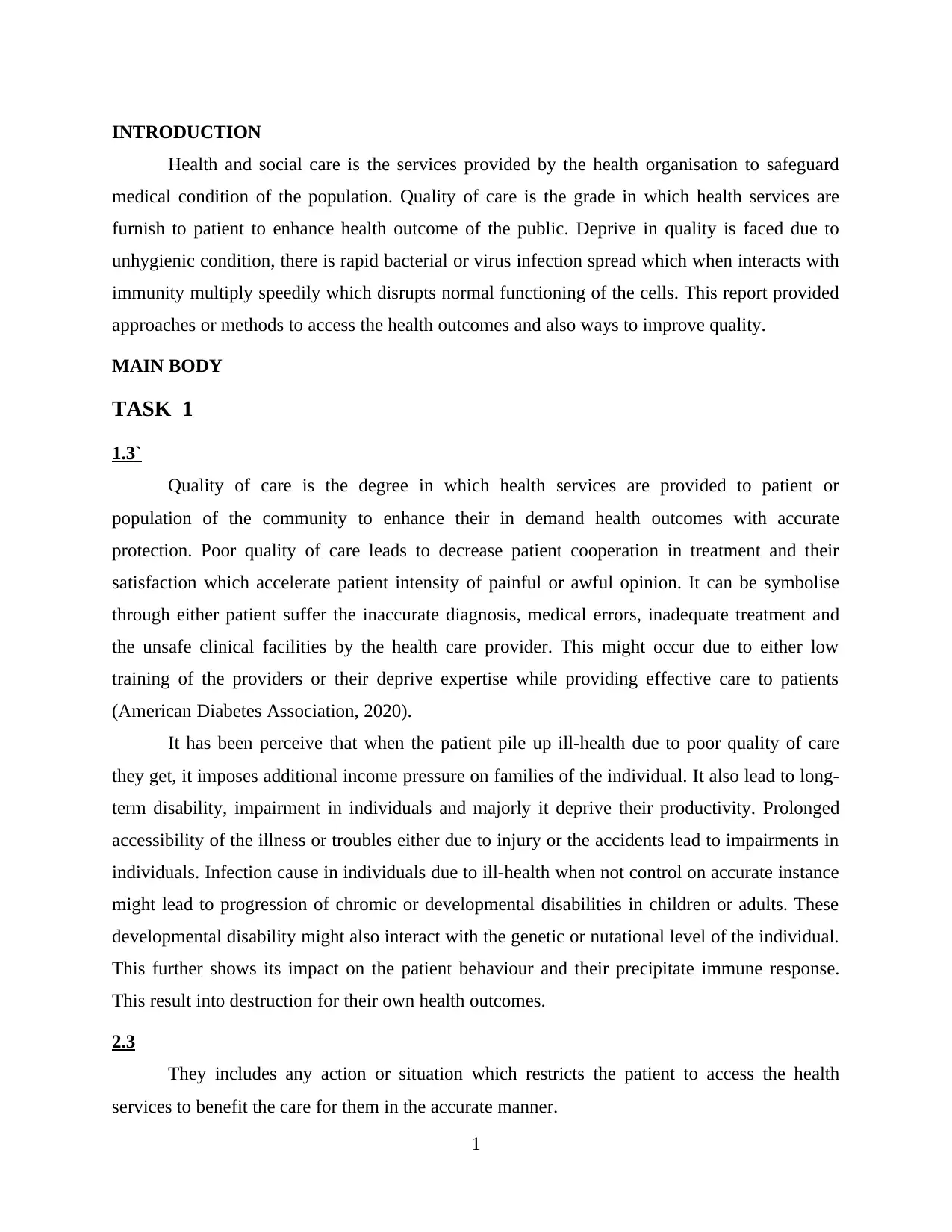
INTRODUCTION
Health and social care is the services provided by the health organisation to safeguard
medical condition of the population. Quality of care is the grade in which health services are
furnish to patient to enhance health outcome of the public. Deprive in quality is faced due to
unhygienic condition, there is rapid bacterial or virus infection spread which when interacts with
immunity multiply speedily which disrupts normal functioning of the cells. This report provided
approaches or methods to access the health outcomes and also ways to improve quality.
MAIN BODY
TASK 1
1.3`
Quality of care is the degree in which health services are provided to patient or
population of the community to enhance their in demand health outcomes with accurate
protection. Poor quality of care leads to decrease patient cooperation in treatment and their
satisfaction which accelerate patient intensity of painful or awful opinion. It can be symbolise
through either patient suffer the inaccurate diagnosis, medical errors, inadequate treatment and
the unsafe clinical facilities by the health care provider. This might occur due to either low
training of the providers or their deprive expertise while providing effective care to patients
(American Diabetes Association, 2020).
It has been perceive that when the patient pile up ill-health due to poor quality of care
they get, it imposes additional income pressure on families of the individual. It also lead to long-
term disability, impairment in individuals and majorly it deprive their productivity. Prolonged
accessibility of the illness or troubles either due to injury or the accidents lead to impairments in
individuals. Infection cause in individuals due to ill-health when not control on accurate instance
might lead to progression of chromic or developmental disabilities in children or adults. These
developmental disability might also interact with the genetic or nutational level of the individual.
This further shows its impact on the patient behaviour and their precipitate immune response.
This result into destruction for their own health outcomes.
2.3
They includes any action or situation which restricts the patient to access the health
services to benefit the care for them in the accurate manner.
1
Health and social care is the services provided by the health organisation to safeguard
medical condition of the population. Quality of care is the grade in which health services are
furnish to patient to enhance health outcome of the public. Deprive in quality is faced due to
unhygienic condition, there is rapid bacterial or virus infection spread which when interacts with
immunity multiply speedily which disrupts normal functioning of the cells. This report provided
approaches or methods to access the health outcomes and also ways to improve quality.
MAIN BODY
TASK 1
1.3`
Quality of care is the degree in which health services are provided to patient or
population of the community to enhance their in demand health outcomes with accurate
protection. Poor quality of care leads to decrease patient cooperation in treatment and their
satisfaction which accelerate patient intensity of painful or awful opinion. It can be symbolise
through either patient suffer the inaccurate diagnosis, medical errors, inadequate treatment and
the unsafe clinical facilities by the health care provider. This might occur due to either low
training of the providers or their deprive expertise while providing effective care to patients
(American Diabetes Association, 2020).
It has been perceive that when the patient pile up ill-health due to poor quality of care
they get, it imposes additional income pressure on families of the individual. It also lead to long-
term disability, impairment in individuals and majorly it deprive their productivity. Prolonged
accessibility of the illness or troubles either due to injury or the accidents lead to impairments in
individuals. Infection cause in individuals due to ill-health when not control on accurate instance
might lead to progression of chromic or developmental disabilities in children or adults. These
developmental disability might also interact with the genetic or nutational level of the individual.
This further shows its impact on the patient behaviour and their precipitate immune response.
This result into destruction for their own health outcomes.
2.3
They includes any action or situation which restricts the patient to access the health
services to benefit the care for them in the accurate manner.
1
⊘ This is a preview!⊘
Do you want full access?
Subscribe today to unlock all pages.

Trusted by 1+ million students worldwide
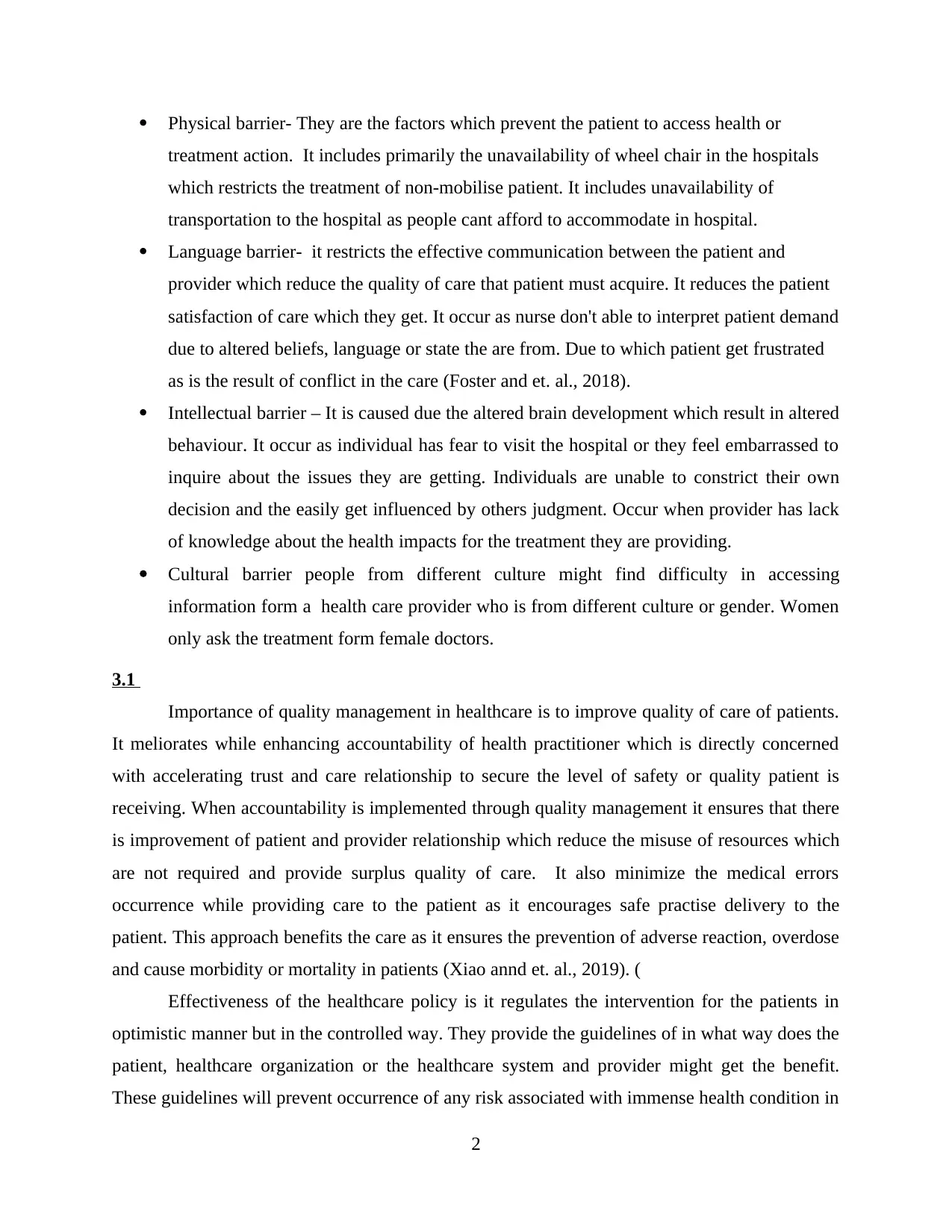
Physical barrier- They are the factors which prevent the patient to access health or
treatment action. It includes primarily the unavailability of wheel chair in the hospitals
which restricts the treatment of non-mobilise patient. It includes unavailability of
transportation to the hospital as people cant afford to accommodate in hospital.
Language barrier- it restricts the effective communication between the patient and
provider which reduce the quality of care that patient must acquire. It reduces the patient
satisfaction of care which they get. It occur as nurse don't able to interpret patient demand
due to altered beliefs, language or state the are from. Due to which patient get frustrated
as is the result of conflict in the care (Foster and et. al., 2018).
Intellectual barrier – It is caused due the altered brain development which result in altered
behaviour. It occur as individual has fear to visit the hospital or they feel embarrassed to
inquire about the issues they are getting. Individuals are unable to constrict their own
decision and the easily get influenced by others judgment. Occur when provider has lack
of knowledge about the health impacts for the treatment they are providing.
Cultural barrier people from different culture might find difficulty in accessing
information form a health care provider who is from different culture or gender. Women
only ask the treatment form female doctors.
3.1
Importance of quality management in healthcare is to improve quality of care of patients.
It meliorates while enhancing accountability of health practitioner which is directly concerned
with accelerating trust and care relationship to secure the level of safety or quality patient is
receiving. When accountability is implemented through quality management it ensures that there
is improvement of patient and provider relationship which reduce the misuse of resources which
are not required and provide surplus quality of care. It also minimize the medical errors
occurrence while providing care to the patient as it encourages safe practise delivery to the
patient. This approach benefits the care as it ensures the prevention of adverse reaction, overdose
and cause morbidity or mortality in patients (Xiao annd et. al., 2019). (
Effectiveness of the healthcare policy is it regulates the intervention for the patients in
optimistic manner but in the controlled way. They provide the guidelines of in what way does the
patient, healthcare organization or the healthcare system and provider might get the benefit.
These guidelines will prevent occurrence of any risk associated with immense health condition in
2
treatment action. It includes primarily the unavailability of wheel chair in the hospitals
which restricts the treatment of non-mobilise patient. It includes unavailability of
transportation to the hospital as people cant afford to accommodate in hospital.
Language barrier- it restricts the effective communication between the patient and
provider which reduce the quality of care that patient must acquire. It reduces the patient
satisfaction of care which they get. It occur as nurse don't able to interpret patient demand
due to altered beliefs, language or state the are from. Due to which patient get frustrated
as is the result of conflict in the care (Foster and et. al., 2018).
Intellectual barrier – It is caused due the altered brain development which result in altered
behaviour. It occur as individual has fear to visit the hospital or they feel embarrassed to
inquire about the issues they are getting. Individuals are unable to constrict their own
decision and the easily get influenced by others judgment. Occur when provider has lack
of knowledge about the health impacts for the treatment they are providing.
Cultural barrier people from different culture might find difficulty in accessing
information form a health care provider who is from different culture or gender. Women
only ask the treatment form female doctors.
3.1
Importance of quality management in healthcare is to improve quality of care of patients.
It meliorates while enhancing accountability of health practitioner which is directly concerned
with accelerating trust and care relationship to secure the level of safety or quality patient is
receiving. When accountability is implemented through quality management it ensures that there
is improvement of patient and provider relationship which reduce the misuse of resources which
are not required and provide surplus quality of care. It also minimize the medical errors
occurrence while providing care to the patient as it encourages safe practise delivery to the
patient. This approach benefits the care as it ensures the prevention of adverse reaction, overdose
and cause morbidity or mortality in patients (Xiao annd et. al., 2019). (
Effectiveness of the healthcare policy is it regulates the intervention for the patients in
optimistic manner but in the controlled way. They provide the guidelines of in what way does the
patient, healthcare organization or the healthcare system and provider might get the benefit.
These guidelines will prevent occurrence of any risk associated with immense health condition in
2
Paraphrase This Document
Need a fresh take? Get an instant paraphrase of this document with our AI Paraphraser
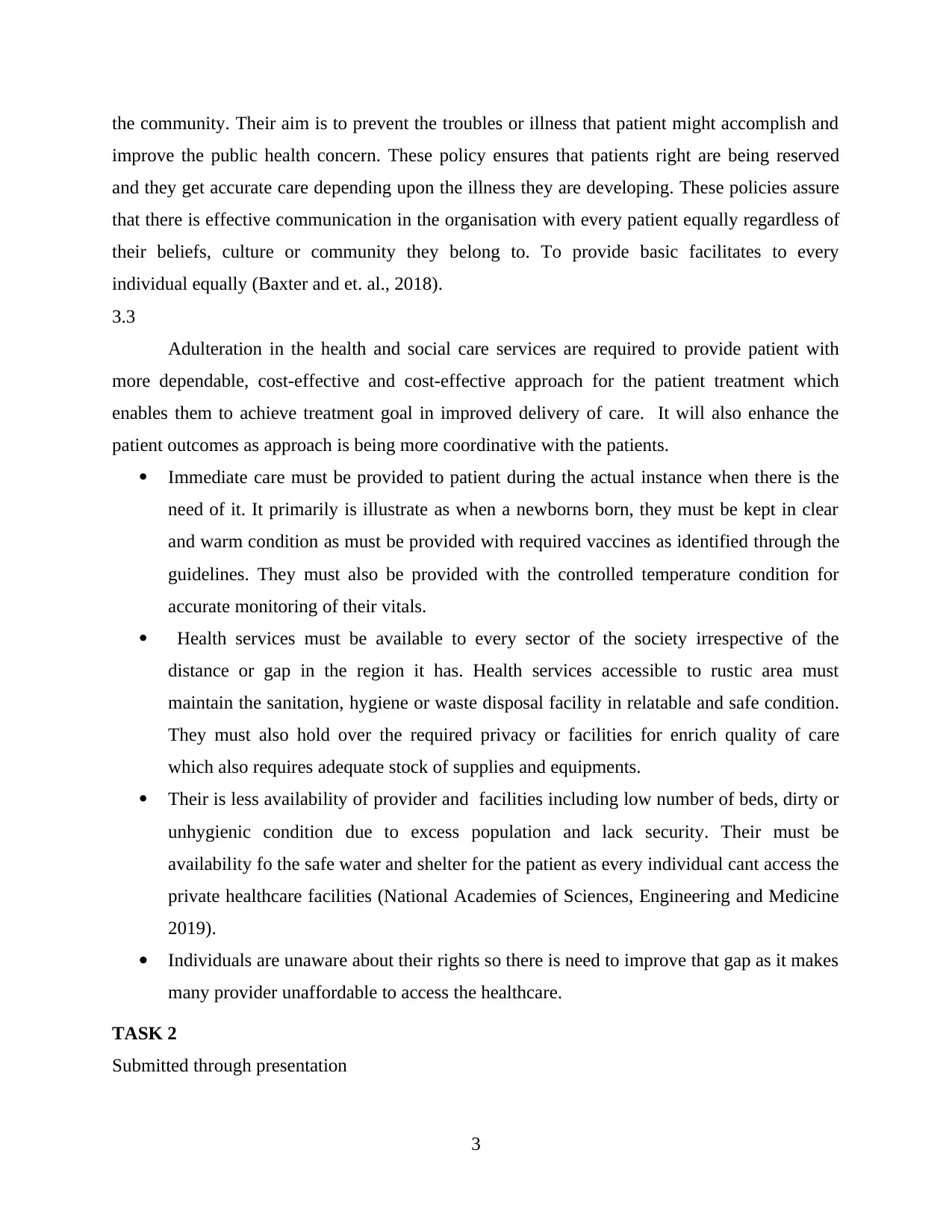
the community. Their aim is to prevent the troubles or illness that patient might accomplish and
improve the public health concern. These policy ensures that patients right are being reserved
and they get accurate care depending upon the illness they are developing. These policies assure
that there is effective communication in the organisation with every patient equally regardless of
their beliefs, culture or community they belong to. To provide basic facilitates to every
individual equally (Baxter and et. al., 2018).
3.3
Adulteration in the health and social care services are required to provide patient with
more dependable, cost-effective and cost-effective approach for the patient treatment which
enables them to achieve treatment goal in improved delivery of care. It will also enhance the
patient outcomes as approach is being more coordinative with the patients.
Immediate care must be provided to patient during the actual instance when there is the
need of it. It primarily is illustrate as when a newborns born, they must be kept in clear
and warm condition as must be provided with required vaccines as identified through the
guidelines. They must also be provided with the controlled temperature condition for
accurate monitoring of their vitals.
Health services must be available to every sector of the society irrespective of the
distance or gap in the region it has. Health services accessible to rustic area must
maintain the sanitation, hygiene or waste disposal facility in relatable and safe condition.
They must also hold over the required privacy or facilities for enrich quality of care
which also requires adequate stock of supplies and equipments.
Their is less availability of provider and facilities including low number of beds, dirty or
unhygienic condition due to excess population and lack security. Their must be
availability fo the safe water and shelter for the patient as every individual cant access the
private healthcare facilities (National Academies of Sciences, Engineering and Medicine
2019).
Individuals are unaware about their rights so there is need to improve that gap as it makes
many provider unaffordable to access the healthcare.
TASK 2
Submitted through presentation
3
improve the public health concern. These policy ensures that patients right are being reserved
and they get accurate care depending upon the illness they are developing. These policies assure
that there is effective communication in the organisation with every patient equally regardless of
their beliefs, culture or community they belong to. To provide basic facilitates to every
individual equally (Baxter and et. al., 2018).
3.3
Adulteration in the health and social care services are required to provide patient with
more dependable, cost-effective and cost-effective approach for the patient treatment which
enables them to achieve treatment goal in improved delivery of care. It will also enhance the
patient outcomes as approach is being more coordinative with the patients.
Immediate care must be provided to patient during the actual instance when there is the
need of it. It primarily is illustrate as when a newborns born, they must be kept in clear
and warm condition as must be provided with required vaccines as identified through the
guidelines. They must also be provided with the controlled temperature condition for
accurate monitoring of their vitals.
Health services must be available to every sector of the society irrespective of the
distance or gap in the region it has. Health services accessible to rustic area must
maintain the sanitation, hygiene or waste disposal facility in relatable and safe condition.
They must also hold over the required privacy or facilities for enrich quality of care
which also requires adequate stock of supplies and equipments.
Their is less availability of provider and facilities including low number of beds, dirty or
unhygienic condition due to excess population and lack security. Their must be
availability fo the safe water and shelter for the patient as every individual cant access the
private healthcare facilities (National Academies of Sciences, Engineering and Medicine
2019).
Individuals are unaware about their rights so there is need to improve that gap as it makes
many provider unaffordable to access the healthcare.
TASK 2
Submitted through presentation
3
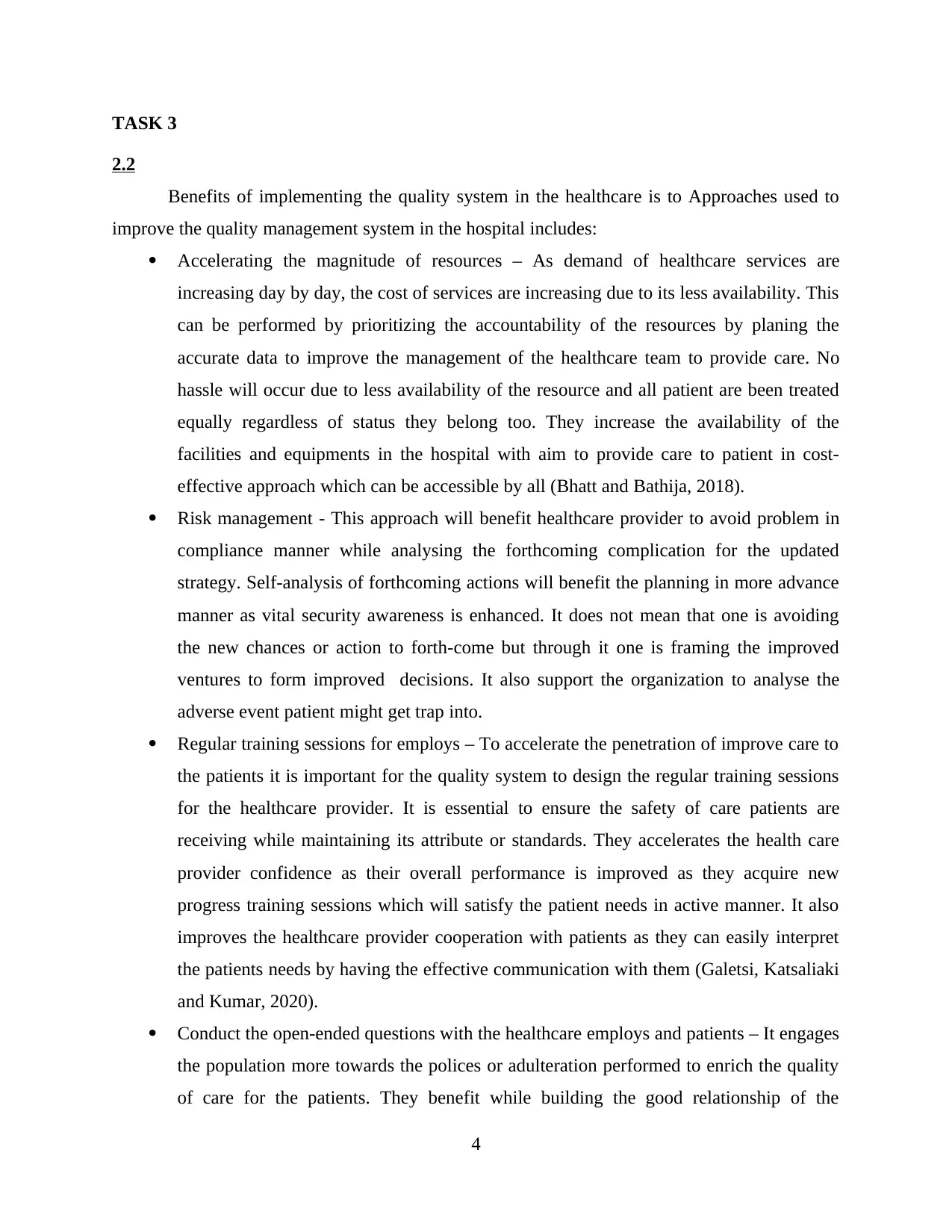
TASK 3
2.2
Benefits of implementing the quality system in the healthcare is to Approaches used to
improve the quality management system in the hospital includes:
Accelerating the magnitude of resources – As demand of healthcare services are
increasing day by day, the cost of services are increasing due to its less availability. This
can be performed by prioritizing the accountability of the resources by planing the
accurate data to improve the management of the healthcare team to provide care. No
hassle will occur due to less availability of the resource and all patient are been treated
equally regardless of status they belong too. They increase the availability of the
facilities and equipments in the hospital with aim to provide care to patient in cost-
effective approach which can be accessible by all (Bhatt and Bathija, 2018).
Risk management - This approach will benefit healthcare provider to avoid problem in
compliance manner while analysing the forthcoming complication for the updated
strategy. Self-analysis of forthcoming actions will benefit the planning in more advance
manner as vital security awareness is enhanced. It does not mean that one is avoiding
the new chances or action to forth-come but through it one is framing the improved
ventures to form improved decisions. It also support the organization to analyse the
adverse event patient might get trap into.
Regular training sessions for employs – To accelerate the penetration of improve care to
the patients it is important for the quality system to design the regular training sessions
for the healthcare provider. It is essential to ensure the safety of care patients are
receiving while maintaining its attribute or standards. They accelerates the health care
provider confidence as their overall performance is improved as they acquire new
progress training sessions which will satisfy the patient needs in active manner. It also
improves the healthcare provider cooperation with patients as they can easily interpret
the patients needs by having the effective communication with them (Galetsi, Katsaliaki
and Kumar, 2020).
Conduct the open-ended questions with the healthcare employs and patients – It engages
the population more towards the polices or adulteration performed to enrich the quality
of care for the patients. They benefit while building the good relationship of the
4
2.2
Benefits of implementing the quality system in the healthcare is to Approaches used to
improve the quality management system in the hospital includes:
Accelerating the magnitude of resources – As demand of healthcare services are
increasing day by day, the cost of services are increasing due to its less availability. This
can be performed by prioritizing the accountability of the resources by planing the
accurate data to improve the management of the healthcare team to provide care. No
hassle will occur due to less availability of the resource and all patient are been treated
equally regardless of status they belong too. They increase the availability of the
facilities and equipments in the hospital with aim to provide care to patient in cost-
effective approach which can be accessible by all (Bhatt and Bathija, 2018).
Risk management - This approach will benefit healthcare provider to avoid problem in
compliance manner while analysing the forthcoming complication for the updated
strategy. Self-analysis of forthcoming actions will benefit the planning in more advance
manner as vital security awareness is enhanced. It does not mean that one is avoiding
the new chances or action to forth-come but through it one is framing the improved
ventures to form improved decisions. It also support the organization to analyse the
adverse event patient might get trap into.
Regular training sessions for employs – To accelerate the penetration of improve care to
the patients it is important for the quality system to design the regular training sessions
for the healthcare provider. It is essential to ensure the safety of care patients are
receiving while maintaining its attribute or standards. They accelerates the health care
provider confidence as their overall performance is improved as they acquire new
progress training sessions which will satisfy the patient needs in active manner. It also
improves the healthcare provider cooperation with patients as they can easily interpret
the patients needs by having the effective communication with them (Galetsi, Katsaliaki
and Kumar, 2020).
Conduct the open-ended questions with the healthcare employs and patients – It engages
the population more towards the polices or adulteration performed to enrich the quality
of care for the patients. They benefit while building the good relationship of the
4
⊘ This is a preview!⊘
Do you want full access?
Subscribe today to unlock all pages.

Trusted by 1+ million students worldwide
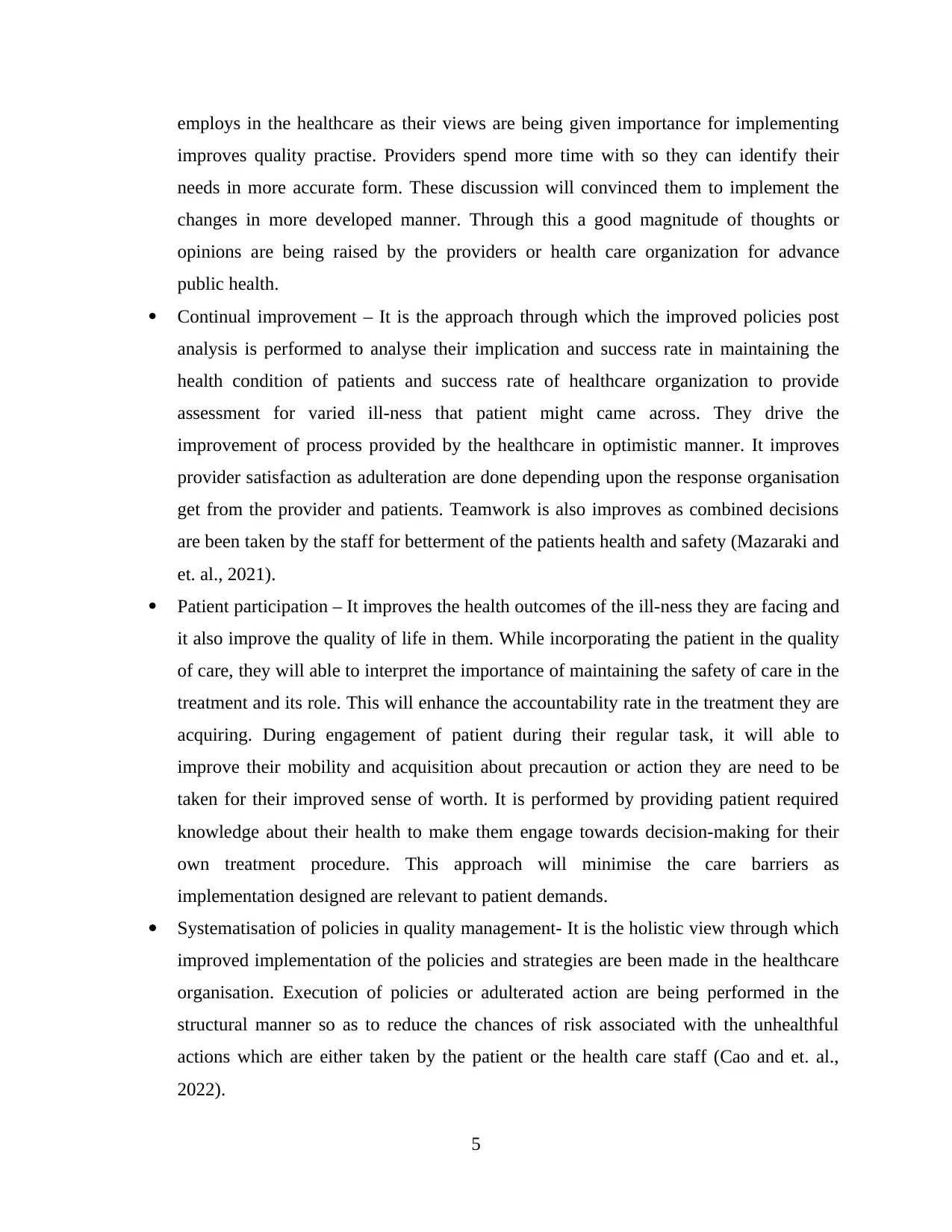
employs in the healthcare as their views are being given importance for implementing
improves quality practise. Providers spend more time with so they can identify their
needs in more accurate form. These discussion will convinced them to implement the
changes in more developed manner. Through this a good magnitude of thoughts or
opinions are being raised by the providers or health care organization for advance
public health.
Continual improvement – It is the approach through which the improved policies post
analysis is performed to analyse their implication and success rate in maintaining the
health condition of patients and success rate of healthcare organization to provide
assessment for varied ill-ness that patient might came across. They drive the
improvement of process provided by the healthcare in optimistic manner. It improves
provider satisfaction as adulteration are done depending upon the response organisation
get from the provider and patients. Teamwork is also improves as combined decisions
are been taken by the staff for betterment of the patients health and safety (Mazaraki and
et. al., 2021).
Patient participation – It improves the health outcomes of the ill-ness they are facing and
it also improve the quality of life in them. While incorporating the patient in the quality
of care, they will able to interpret the importance of maintaining the safety of care in the
treatment and its role. This will enhance the accountability rate in the treatment they are
acquiring. During engagement of patient during their regular task, it will able to
improve their mobility and acquisition about precaution or action they are need to be
taken for their improved sense of worth. It is performed by providing patient required
knowledge about their health to make them engage towards decision-making for their
own treatment procedure. This approach will minimise the care barriers as
implementation designed are relevant to patient demands.
Systematisation of policies in quality management- It is the holistic view through which
improved implementation of the policies and strategies are been made in the healthcare
organisation. Execution of policies or adulterated action are being performed in the
structural manner so as to reduce the chances of risk associated with the unhealthful
actions which are either taken by the patient or the health care staff (Cao and et. al.,
2022).
5
improves quality practise. Providers spend more time with so they can identify their
needs in more accurate form. These discussion will convinced them to implement the
changes in more developed manner. Through this a good magnitude of thoughts or
opinions are being raised by the providers or health care organization for advance
public health.
Continual improvement – It is the approach through which the improved policies post
analysis is performed to analyse their implication and success rate in maintaining the
health condition of patients and success rate of healthcare organization to provide
assessment for varied ill-ness that patient might came across. They drive the
improvement of process provided by the healthcare in optimistic manner. It improves
provider satisfaction as adulteration are done depending upon the response organisation
get from the provider and patients. Teamwork is also improves as combined decisions
are been taken by the staff for betterment of the patients health and safety (Mazaraki and
et. al., 2021).
Patient participation – It improves the health outcomes of the ill-ness they are facing and
it also improve the quality of life in them. While incorporating the patient in the quality
of care, they will able to interpret the importance of maintaining the safety of care in the
treatment and its role. This will enhance the accountability rate in the treatment they are
acquiring. During engagement of patient during their regular task, it will able to
improve their mobility and acquisition about precaution or action they are need to be
taken for their improved sense of worth. It is performed by providing patient required
knowledge about their health to make them engage towards decision-making for their
own treatment procedure. This approach will minimise the care barriers as
implementation designed are relevant to patient demands.
Systematisation of policies in quality management- It is the holistic view through which
improved implementation of the policies and strategies are been made in the healthcare
organisation. Execution of policies or adulterated action are being performed in the
structural manner so as to reduce the chances of risk associated with the unhealthful
actions which are either taken by the patient or the health care staff (Cao and et. al.,
2022).
5
Paraphrase This Document
Need a fresh take? Get an instant paraphrase of this document with our AI Paraphraser
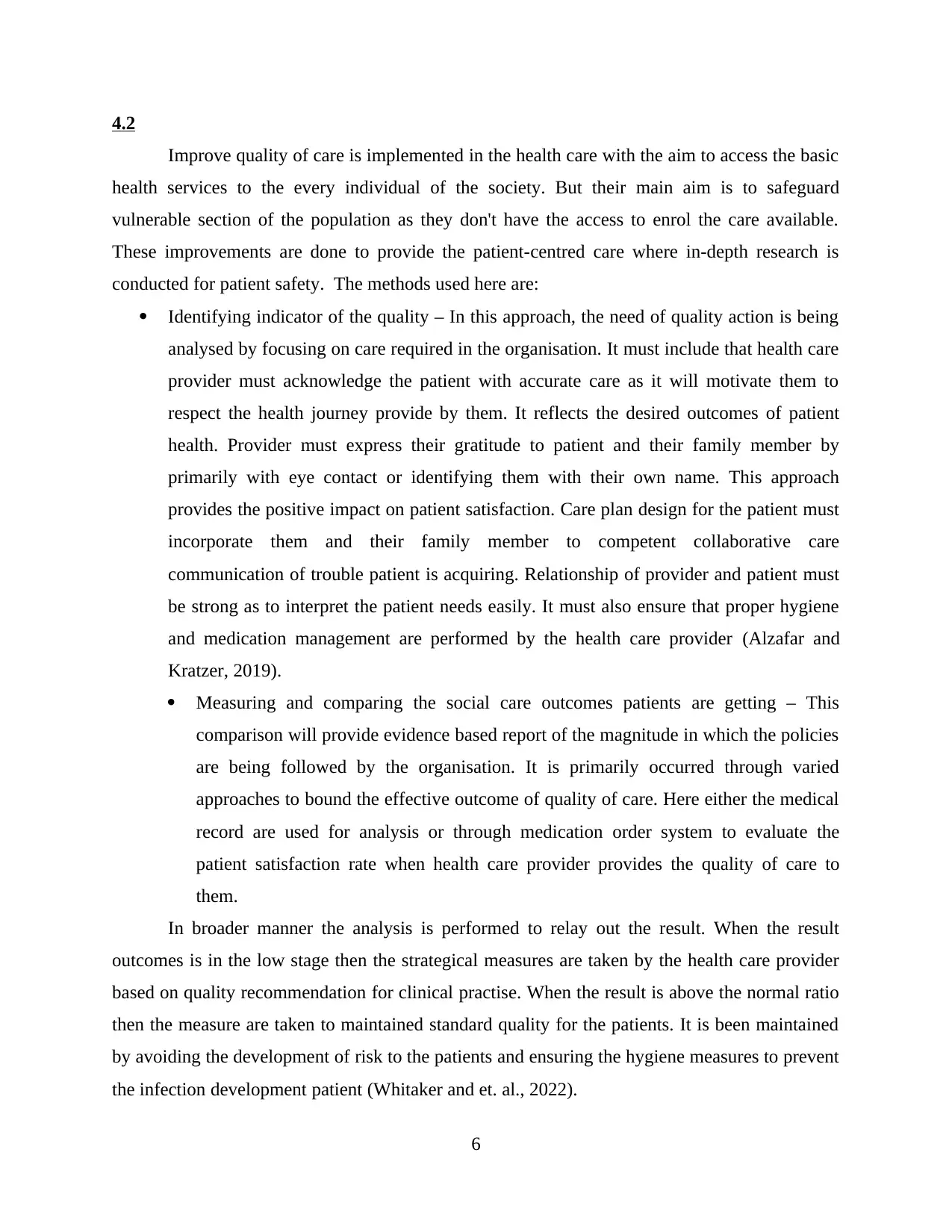
4.2
Improve quality of care is implemented in the health care with the aim to access the basic
health services to the every individual of the society. But their main aim is to safeguard
vulnerable section of the population as they don't have the access to enrol the care available.
These improvements are done to provide the patient-centred care where in-depth research is
conducted for patient safety. The methods used here are:
Identifying indicator of the quality – In this approach, the need of quality action is being
analysed by focusing on care required in the organisation. It must include that health care
provider must acknowledge the patient with accurate care as it will motivate them to
respect the health journey provide by them. It reflects the desired outcomes of patient
health. Provider must express their gratitude to patient and their family member by
primarily with eye contact or identifying them with their own name. This approach
provides the positive impact on patient satisfaction. Care plan design for the patient must
incorporate them and their family member to competent collaborative care
communication of trouble patient is acquiring. Relationship of provider and patient must
be strong as to interpret the patient needs easily. It must also ensure that proper hygiene
and medication management are performed by the health care provider (Alzafar and
Kratzer, 2019).
Measuring and comparing the social care outcomes patients are getting – This
comparison will provide evidence based report of the magnitude in which the policies
are being followed by the organisation. It is primarily occurred through varied
approaches to bound the effective outcome of quality of care. Here either the medical
record are used for analysis or through medication order system to evaluate the
patient satisfaction rate when health care provider provides the quality of care to
them.
In broader manner the analysis is performed to relay out the result. When the result
outcomes is in the low stage then the strategical measures are taken by the health care provider
based on quality recommendation for clinical practise. When the result is above the normal ratio
then the measure are taken to maintained standard quality for the patients. It is been maintained
by avoiding the development of risk to the patients and ensuring the hygiene measures to prevent
the infection development patient (Whitaker and et. al., 2022).
6
Improve quality of care is implemented in the health care with the aim to access the basic
health services to the every individual of the society. But their main aim is to safeguard
vulnerable section of the population as they don't have the access to enrol the care available.
These improvements are done to provide the patient-centred care where in-depth research is
conducted for patient safety. The methods used here are:
Identifying indicator of the quality – In this approach, the need of quality action is being
analysed by focusing on care required in the organisation. It must include that health care
provider must acknowledge the patient with accurate care as it will motivate them to
respect the health journey provide by them. It reflects the desired outcomes of patient
health. Provider must express their gratitude to patient and their family member by
primarily with eye contact or identifying them with their own name. This approach
provides the positive impact on patient satisfaction. Care plan design for the patient must
incorporate them and their family member to competent collaborative care
communication of trouble patient is acquiring. Relationship of provider and patient must
be strong as to interpret the patient needs easily. It must also ensure that proper hygiene
and medication management are performed by the health care provider (Alzafar and
Kratzer, 2019).
Measuring and comparing the social care outcomes patients are getting – This
comparison will provide evidence based report of the magnitude in which the policies
are being followed by the organisation. It is primarily occurred through varied
approaches to bound the effective outcome of quality of care. Here either the medical
record are used for analysis or through medication order system to evaluate the
patient satisfaction rate when health care provider provides the quality of care to
them.
In broader manner the analysis is performed to relay out the result. When the result
outcomes is in the low stage then the strategical measures are taken by the health care provider
based on quality recommendation for clinical practise. When the result is above the normal ratio
then the measure are taken to maintained standard quality for the patients. It is been maintained
by avoiding the development of risk to the patients and ensuring the hygiene measures to prevent
the infection development patient (Whitaker and et. al., 2022).
6
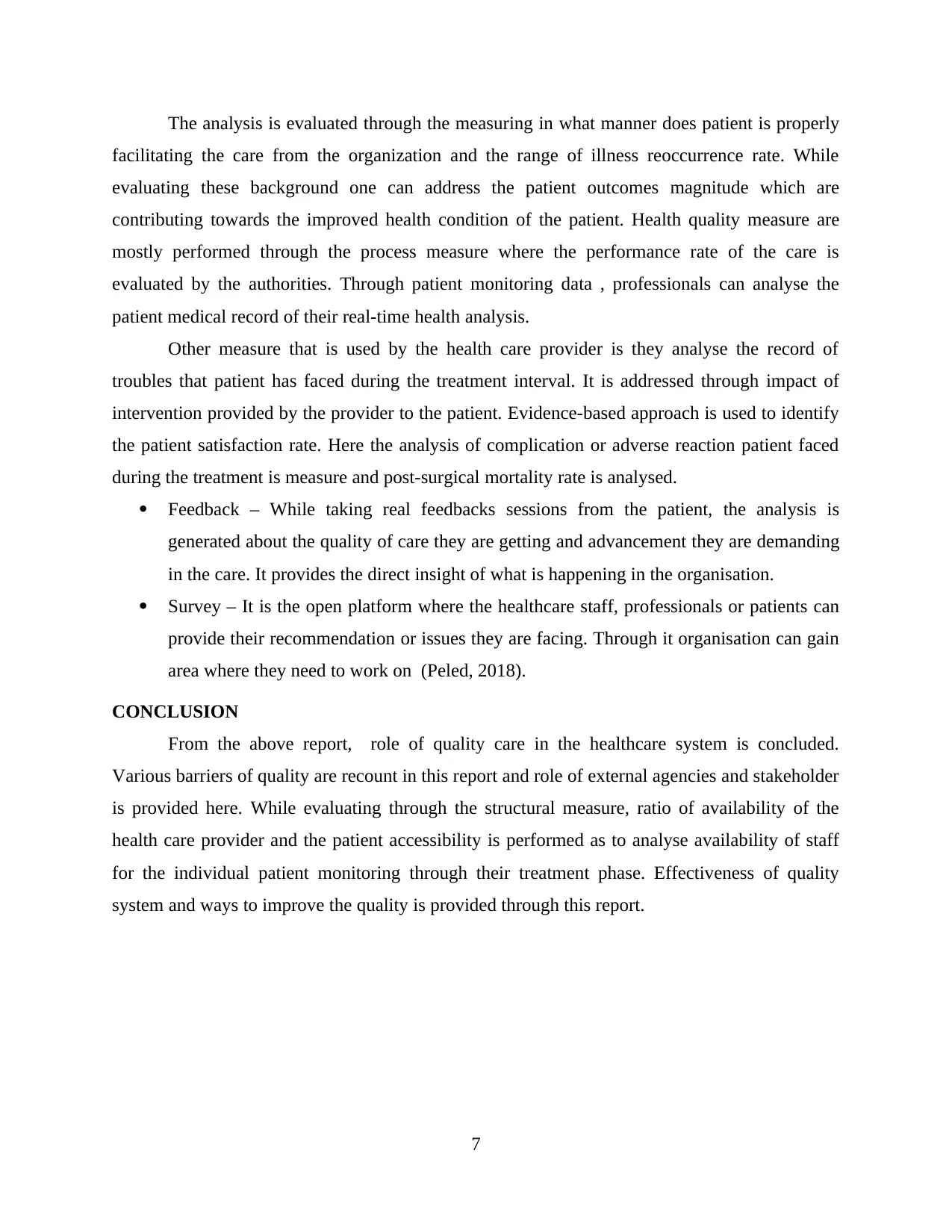
The analysis is evaluated through the measuring in what manner does patient is properly
facilitating the care from the organization and the range of illness reoccurrence rate. While
evaluating these background one can address the patient outcomes magnitude which are
contributing towards the improved health condition of the patient. Health quality measure are
mostly performed through the process measure where the performance rate of the care is
evaluated by the authorities. Through patient monitoring data , professionals can analyse the
patient medical record of their real-time health analysis.
Other measure that is used by the health care provider is they analyse the record of
troubles that patient has faced during the treatment interval. It is addressed through impact of
intervention provided by the provider to the patient. Evidence-based approach is used to identify
the patient satisfaction rate. Here the analysis of complication or adverse reaction patient faced
during the treatment is measure and post-surgical mortality rate is analysed.
Feedback – While taking real feedbacks sessions from the patient, the analysis is
generated about the quality of care they are getting and advancement they are demanding
in the care. It provides the direct insight of what is happening in the organisation.
Survey – It is the open platform where the healthcare staff, professionals or patients can
provide their recommendation or issues they are facing. Through it organisation can gain
area where they need to work on (Peled, 2018).
CONCLUSION
From the above report, role of quality care in the healthcare system is concluded.
Various barriers of quality are recount in this report and role of external agencies and stakeholder
is provided here. While evaluating through the structural measure, ratio of availability of the
health care provider and the patient accessibility is performed as to analyse availability of staff
for the individual patient monitoring through their treatment phase. Effectiveness of quality
system and ways to improve the quality is provided through this report.
7
facilitating the care from the organization and the range of illness reoccurrence rate. While
evaluating these background one can address the patient outcomes magnitude which are
contributing towards the improved health condition of the patient. Health quality measure are
mostly performed through the process measure where the performance rate of the care is
evaluated by the authorities. Through patient monitoring data , professionals can analyse the
patient medical record of their real-time health analysis.
Other measure that is used by the health care provider is they analyse the record of
troubles that patient has faced during the treatment interval. It is addressed through impact of
intervention provided by the provider to the patient. Evidence-based approach is used to identify
the patient satisfaction rate. Here the analysis of complication or adverse reaction patient faced
during the treatment is measure and post-surgical mortality rate is analysed.
Feedback – While taking real feedbacks sessions from the patient, the analysis is
generated about the quality of care they are getting and advancement they are demanding
in the care. It provides the direct insight of what is happening in the organisation.
Survey – It is the open platform where the healthcare staff, professionals or patients can
provide their recommendation or issues they are facing. Through it organisation can gain
area where they need to work on (Peled, 2018).
CONCLUSION
From the above report, role of quality care in the healthcare system is concluded.
Various barriers of quality are recount in this report and role of external agencies and stakeholder
is provided here. While evaluating through the structural measure, ratio of availability of the
health care provider and the patient accessibility is performed as to analyse availability of staff
for the individual patient monitoring through their treatment phase. Effectiveness of quality
system and ways to improve the quality is provided through this report.
7
⊘ This is a preview!⊘
Do you want full access?
Subscribe today to unlock all pages.

Trusted by 1+ million students worldwide
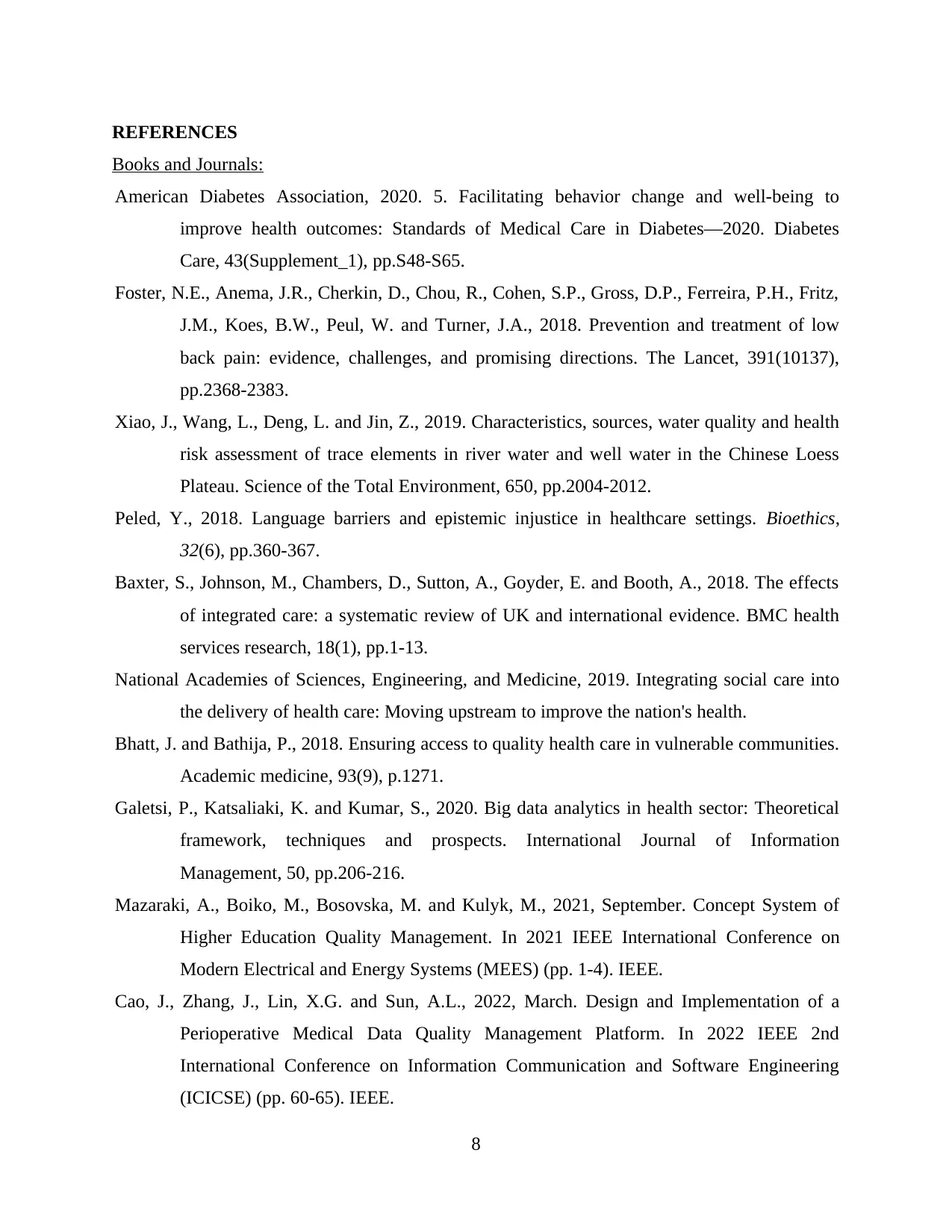
REFERENCES
Books and Journals:
American Diabetes Association, 2020. 5. Facilitating behavior change and well-being to
improve health outcomes: Standards of Medical Care in Diabetes—2020. Diabetes
Care, 43(Supplement_1), pp.S48-S65.
Foster, N.E., Anema, J.R., Cherkin, D., Chou, R., Cohen, S.P., Gross, D.P., Ferreira, P.H., Fritz,
J.M., Koes, B.W., Peul, W. and Turner, J.A., 2018. Prevention and treatment of low
back pain: evidence, challenges, and promising directions. The Lancet, 391(10137),
pp.2368-2383.
Xiao, J., Wang, L., Deng, L. and Jin, Z., 2019. Characteristics, sources, water quality and health
risk assessment of trace elements in river water and well water in the Chinese Loess
Plateau. Science of the Total Environment, 650, pp.2004-2012.
Peled, Y., 2018. Language barriers and epistemic injustice in healthcare settings. Bioethics,
32(6), pp.360-367.
Baxter, S., Johnson, M., Chambers, D., Sutton, A., Goyder, E. and Booth, A., 2018. The effects
of integrated care: a systematic review of UK and international evidence. BMC health
services research, 18(1), pp.1-13.
National Academies of Sciences, Engineering, and Medicine, 2019. Integrating social care into
the delivery of health care: Moving upstream to improve the nation's health.
Bhatt, J. and Bathija, P., 2018. Ensuring access to quality health care in vulnerable communities.
Academic medicine, 93(9), p.1271.
Galetsi, P., Katsaliaki, K. and Kumar, S., 2020. Big data analytics in health sector: Theoretical
framework, techniques and prospects. International Journal of Information
Management, 50, pp.206-216.
Mazaraki, A., Boiko, M., Bosovska, M. and Kulyk, M., 2021, September. Concept System of
Higher Education Quality Management. In 2021 IEEE International Conference on
Modern Electrical and Energy Systems (MEES) (pp. 1-4). IEEE.
Cao, J., Zhang, J., Lin, X.G. and Sun, A.L., 2022, March. Design and Implementation of a
Perioperative Medical Data Quality Management Platform. In 2022 IEEE 2nd
International Conference on Information Communication and Software Engineering
(ICICSE) (pp. 60-65). IEEE.
8
Books and Journals:
American Diabetes Association, 2020. 5. Facilitating behavior change and well-being to
improve health outcomes: Standards of Medical Care in Diabetes—2020. Diabetes
Care, 43(Supplement_1), pp.S48-S65.
Foster, N.E., Anema, J.R., Cherkin, D., Chou, R., Cohen, S.P., Gross, D.P., Ferreira, P.H., Fritz,
J.M., Koes, B.W., Peul, W. and Turner, J.A., 2018. Prevention and treatment of low
back pain: evidence, challenges, and promising directions. The Lancet, 391(10137),
pp.2368-2383.
Xiao, J., Wang, L., Deng, L. and Jin, Z., 2019. Characteristics, sources, water quality and health
risk assessment of trace elements in river water and well water in the Chinese Loess
Plateau. Science of the Total Environment, 650, pp.2004-2012.
Peled, Y., 2018. Language barriers and epistemic injustice in healthcare settings. Bioethics,
32(6), pp.360-367.
Baxter, S., Johnson, M., Chambers, D., Sutton, A., Goyder, E. and Booth, A., 2018. The effects
of integrated care: a systematic review of UK and international evidence. BMC health
services research, 18(1), pp.1-13.
National Academies of Sciences, Engineering, and Medicine, 2019. Integrating social care into
the delivery of health care: Moving upstream to improve the nation's health.
Bhatt, J. and Bathija, P., 2018. Ensuring access to quality health care in vulnerable communities.
Academic medicine, 93(9), p.1271.
Galetsi, P., Katsaliaki, K. and Kumar, S., 2020. Big data analytics in health sector: Theoretical
framework, techniques and prospects. International Journal of Information
Management, 50, pp.206-216.
Mazaraki, A., Boiko, M., Bosovska, M. and Kulyk, M., 2021, September. Concept System of
Higher Education Quality Management. In 2021 IEEE International Conference on
Modern Electrical and Energy Systems (MEES) (pp. 1-4). IEEE.
Cao, J., Zhang, J., Lin, X.G. and Sun, A.L., 2022, March. Design and Implementation of a
Perioperative Medical Data Quality Management Platform. In 2022 IEEE 2nd
International Conference on Information Communication and Software Engineering
(ICICSE) (pp. 60-65). IEEE.
8
Paraphrase This Document
Need a fresh take? Get an instant paraphrase of this document with our AI Paraphraser
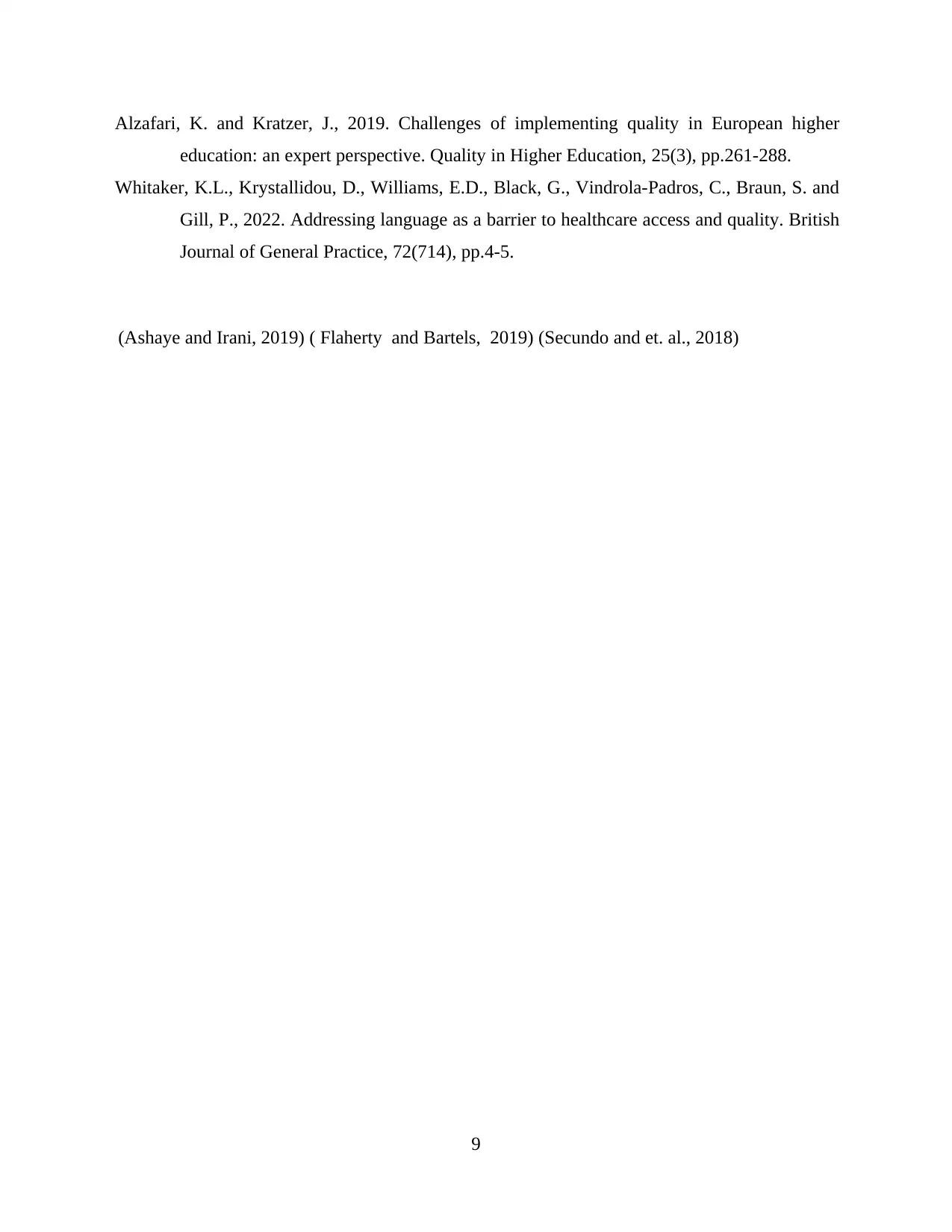
Alzafari, K. and Kratzer, J., 2019. Challenges of implementing quality in European higher
education: an expert perspective. Quality in Higher Education, 25(3), pp.261-288.
Whitaker, K.L., Krystallidou, D., Williams, E.D., Black, G., Vindrola-Padros, C., Braun, S. and
Gill, P., 2022. Addressing language as a barrier to healthcare access and quality. British
Journal of General Practice, 72(714), pp.4-5.
(Ashaye and Irani, 2019) ( Flaherty and Bartels, 2019) (Secundo and et. al., 2018)
9
education: an expert perspective. Quality in Higher Education, 25(3), pp.261-288.
Whitaker, K.L., Krystallidou, D., Williams, E.D., Black, G., Vindrola-Padros, C., Braun, S. and
Gill, P., 2022. Addressing language as a barrier to healthcare access and quality. British
Journal of General Practice, 72(714), pp.4-5.
(Ashaye and Irani, 2019) ( Flaherty and Bartels, 2019) (Secundo and et. al., 2018)
9
1 out of 11
Related Documents
Your All-in-One AI-Powered Toolkit for Academic Success.
+13062052269
info@desklib.com
Available 24*7 on WhatsApp / Email
![[object Object]](/_next/static/media/star-bottom.7253800d.svg)
Unlock your academic potential
Copyright © 2020–2025 A2Z Services. All Rights Reserved. Developed and managed by ZUCOL.




